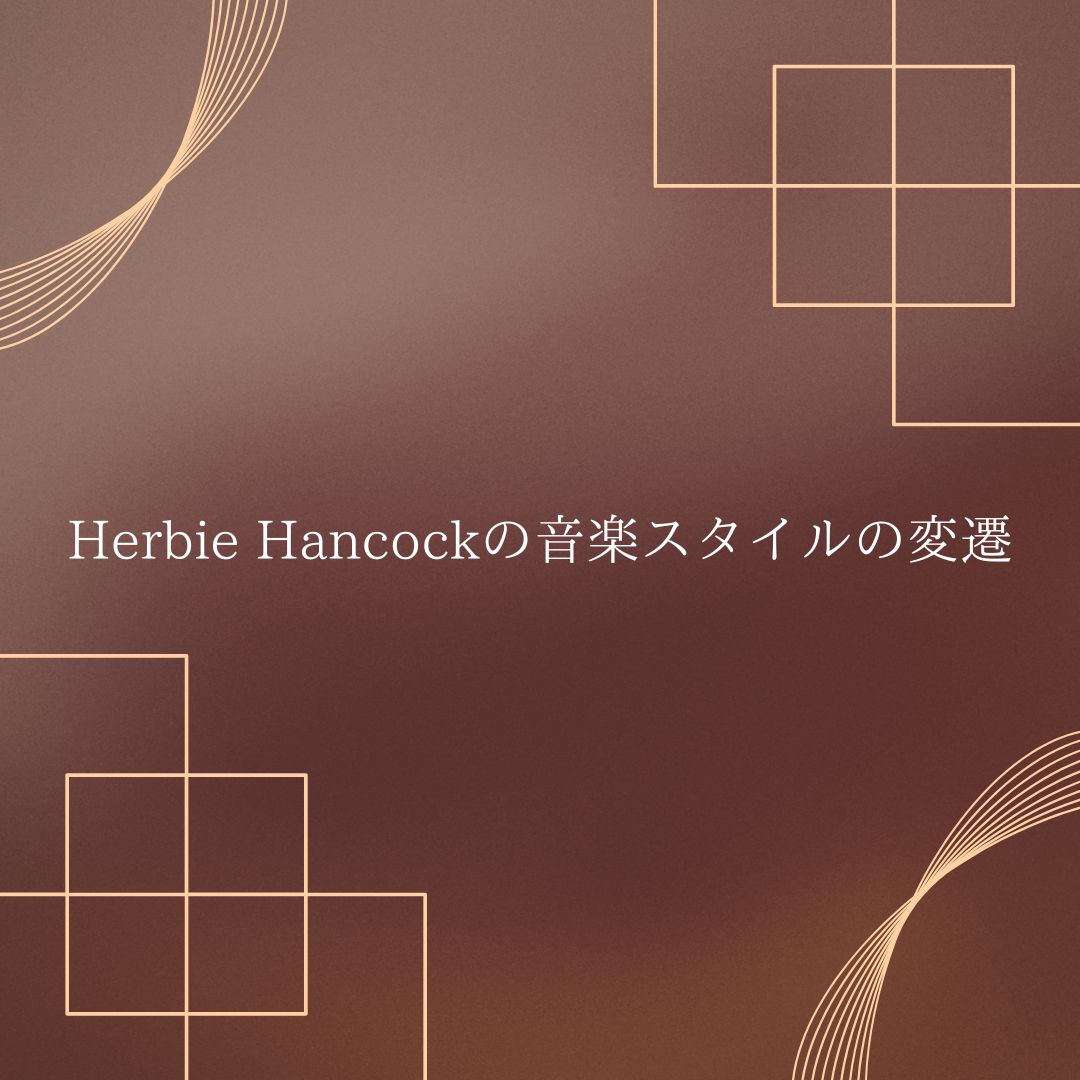Herbie Hancock(ハービー・ハンコック)は、ジャズの進化を象徴するピアニスト/キーボーディスト/作曲家であり、1960年代のハード・バップから、フュージョン、エレクトロニック・ミュージック、ヒップホップとの融合まで、常に時代の先端を切り拓いてきたアーティストです。
Herbie Hancock’s musical style changes
Herbie Hancock is a pianist, keyboardist, and composer who symbolizes the evolution of jazz. He is an artist who has always been at the forefront of his time, from the hard bop of the 1960s to fusion, electronic music, and hip hop.
1️⃣ 1960年代前半 – ハード・バップ&モード・ジャズ
🔹 マイルス・デイヴィス・クインテットでの活躍
ハンコックは、1963年にマイルス・デイヴィスの「第二期黄金クインテット」に参加。モーダルな即興演奏と、従来のハード・バップを発展させたプレイで注目を集めました。
1️⃣ Early 1960s – Hard Bop and Modal Jazz
🔹 Miles Davis Quintet
Hancock joined Miles Davis’ “Second Golden Quintet” in 1963, and attracted attention for his modal improvisation and his development of traditional hard bop playing.
🎵 代表アルバム&曲
『Takin’ Off』(1962年) 代表曲:「Watermelon Man」
→ ファンキーでキャッチーなテーマが特徴のハンコックの最初のヒット曲
🎵 Representative albums and songs
“Takin’ Off” (1962) Signature song: “Watermelon Man”
→ Hancock’s first hit song, featuring a funky and catchy theme
マイルス・デイヴィス『E.S.P.』(1965年) 代表曲:「E.S.P.」「Agitation」
→ モード・ジャズとフリーな即興演奏が融合した革新的な作品
Miles Davis “E.S.P.” (1965) Key songs: “E.S.P.”, “Agitation”
-> An innovative work that combines modal jazz and free improvisation
『Maiden Voyage』(1965年) 代表曲:「Maiden Voyage」「Dolphin Dance」
→ 静かで洗練された美しさを持つモード・ジャズの名盤
“Maiden Voyage” (1965) Key songs: “Maiden Voyage” and “Dolphin Dance”
→ A masterpiece of modal jazz with a quiet and sophisticated beauty
🎹 この時代の特徴
ハード・バップの延長としてのブルース感のあるフレージング、モード・ジャズの影響による空間を生かした和声リズム、セクションの自由度の拡張(トニー・ウィリアムスの革新的なドラムが影響)
🎹 Characteristics of this era
Bluesy phrasing as an extension of hard bop, harmonic rhythms that make use of space due to the influence of modal jazz, and expanded freedom of section (influenced by Tony Williams’ innovative drumming)
2️⃣ 1960年代後半 – エレクトリック・ジャズへの移行
🔹 電子楽器の導入
1968年以降、ハンコックはエレピ(フェンダー・ローズ)を多用し、よりエレクトリックな音楽へと移行しました。
この変化の背景には、マイルス・デイヴィスのエレクトリック・ジャズへの転向が影響しています。
2️⃣ Late 1960s – The transition to electric jazz
🔹 Introduction of electronic instruments
After 1968, Hancock began to use electric piano (Fender Rhodes) more frequently and moved towards a more electric style of music.
This change was influenced by Miles Davis’s move towards electric jazz.
🎵 代表アルバム&曲
『Speak Like a Child』(1968年) 代表曲:「Riot」
→ より洗練されたハーモニーとファンクの要素が強まる
🎵 Representative albums and songs
“Speak Like a Child” (1968) Signature song: “Riot”
→ More sophisticated harmonies and funk elements
マイルス・デイヴィス『In a Silent Way』(1969年) エレクトリック・ジャズの先駆けとなる重要作
Miles Davis, “In a Silent Way” (1969) A pioneering work of electric jazz
🎹 この時代の特徴
フェンダー・ローズの使用によるウォームで幻想的なサウンド、シンプルなコード進行と浮遊感のあるハーモニー、ファンク・リズムの導入
🎹 Characteristics of this era
Warm and dreamy sound produced by the use of the Fender Rhodes, simple chord progressions and floating harmonies, and the introduction of funk rhythms.
3️⃣ 1970年代 – ジャズ・ファンク/フュージョン時代
🔹「ヘッドハンターズ」結成 – ファンクとの融合
1973年、ハンコックは自身のバンド「The Headhunters(ヘッドハンターズ)」を結成し、ジャズとファンクを融合させた革命的な音楽を生み出しました。これにより、ハンコックはジャズ・ファンク/フュージョンの中心人物となります。
3️⃣ 1970s – Jazz-funk/fusion era
🔹Formation of “Headhunters” – Fusion with Funk
In 1973, Hancock formed his own band, The Headhunters, and created a revolutionary fusion of jazz and funk, making him a central figure in the jazz-funk/fusion movement.
🎵 代表アルバム&曲
『Head Hunters』(1973年) 代表曲:「Chameleon」「Watermelon Man(新バージョン)」
→ シンセサイザーとグルーヴィーなベースラインが特徴のジャズ・ファンクの名盤
🎵 Representative albums and songs
“Head Hunters” (1973) Key songs: “Chameleon” and “Watermelon Man (new version)”
→ A jazz-funk masterpiece featuring synthesizers and groovy bass lines
『Thrust』(1974年) 代表曲:「Actual Proof」
→ さらに複雑なリズムとシンセサイザーを駆使した実験的な作品
“Thrust” (1974) Signature song: “Actual Proof”
-> An experimental piece that makes use of even more complex rhythms and synthesizers
🎹 この時代の特徴
ファンク・ビートの強調、シンセサイザーの多用(アープ・シンセ、クラビネットなど)、エレクトリック・ベースとドラムの強いグルーヴ
🎹 Characteristics of this era
Emphasis on funk beats, heavy use of synthesizers (ARP synths, clavinets, etc.), strong grooves of electric bass and drums
4️⃣ 1980年代 – エレクトロ&ヒップホップの導入
🔹 「Rockit」の衝撃 – ジャズとヒップホップの融合
1983年、ハンコックはアルバム『Future Shock』でヒップホップとエレクトロを取り入れた革新的なサウンドを展開。特に「Rockit」は、スクラッチを取り入れた初のジャズ楽曲として話題となり、MTV世代のリスナーにも人気を博しました。
4️⃣ 1980s – Introduction of electro and hip hop
🔹 The impact of “Rockit” – a fusion of jazz and hip-hop
In 1983, Hancock released his album Future Shock, which introduced hip-hop and electro to create an innovative sound. The track “Rockit” in particular was a hot topic as it was the first jazz track to incorporate scratching, and became popular with listeners of the MTV generation.
🎵 代表アルバム&曲
『Future Shock』(1983年) 代表曲:「Rockit」
→ スクラッチとエレクトロ・ビートを融合した先進的な楽曲
🎵 Representative albums and songs
“Future Shock” (1983) Signature song: “Rockit”
-> An advanced song that combines scratching and electro beats
『Sound-System』(1984年) 代表曲:「Hardrock」
→ よりエレクトロなビートを強調
“Sound-System” (1984) Signature song: “Hardrock”
→ Emphasis on more electronic beats
🎹 この時代の特徴
ヒップホップの要素(スクラッチ、サンプリング)の導入、シンセサイザーを駆使したエレクトロ・サウンド、リズムマシンとシーケンサーの活用
🎹 Characteristics of this era
Introduction of hip-hop elements (scratching, sampling), electro sound using synthesizers, and use of rhythm machines and sequencers
5️⃣ 1990年代以降 – アコースティック回帰&クロスオーバー
🔹 再びアコースティック・ジャズへ
1990年代以降、ハンコックは再びアコースティック・ジャズに回帰しつつも、常に新しいサウンドを模索し続けました。
5️⃣ 1990s and beyond – Acoustic return and crossover
🔹 Return to Acoustic Jazz
Since the 1990s, Hancock has returned to acoustic jazz, but continues to explore new sounds.
🎵 代表アルバム&曲
『The New Standard』(1996年) 代表曲:「All Apologies」(Nirvanaのカバー)
→ ロック/ポップの楽曲をジャズ・アレンジで演奏
🎵 Representative albums and songs
“The New Standard” (1996) Signature song: “All Apologies” (Nirvana cover)
→ Rock/pop songs performed with jazz arrangements
『Gershwin’s World』(1998年) 代表曲:「Summertime」
→ ジャズのルーツに立ち返ったアルバム
“Gershwin’s World” (1998) Signature song: “Summertime”
→ An album that returned to the roots of jazz
🎹 この時代の特徴
アコースティック・ピアノの再評価、ジャズと他ジャンル(クラシック、ポップ)の融合、若手ミュージシャンとのコラボレーション
🎹 Characteristics of this era
Reevaluation of the acoustic piano, fusion of jazz with other genres (classical, pop), collaboration with young musicians
Herbie Hancockは、ジャズの進化と共に常に新しいスタイルを生み出し続けたアーティストです。彼の音楽を聴くことで、ジャズの多様な可能性を感じることができます!
Herbie Hancock is an artist who has always created new styles along with the evolution of jazz. By listening to his music, you can feel the diverse possibilities of jazz!
1960年代:ハード・バップ/モード・ジャズ、1970年代:ジャズ・ファンク/フュージョン、1980年代:エレクトロ&ヒップホップ、1990年代以降:アコースティック回帰&クロスオーバー
1960s: Hard Bop/Modal Jazz, 1970s: Jazz Funk/Fusion, 1980s: Electro and Hip Hop, 1990s and after: Acoustic Return and Crossover
